Discovering Uayma
Now and then, for obvious reasons, the Working Gringos pack a cooler, our two faithful dogs and our cameras into our camioneta to go in search of something beyond our computer monitors. This past weekend, we drove east and took the exit off the 180 Autopista to Valladolid with the intention of exploring the second largest city in Yucatan State. But when we stopped at the intersection of the 180 Libre, we saw one of those ubiquitous blue road signs with the international “historic town” symbol. On it was printed Uayma 13, and it pointed to the right.
We thought we had heard of Uayma (pronounced WHY-mah) somewhere before. Perhaps we had read about it in the local paper, Diario de Yucatán, or maybe someone had mentioned it to us over dinner. We couldn’t remember the context, but we thought Uayma might be famous for its Iglesia (church). So without much discussion, we shrugged, hit the turn signal and changed direction. Another typical road trip.
During the brief eight-minute drive, we pretended to decode the pueblo’s name. We know that uay is Mayan for a number of things, all bad. It’s the common expression for surprise, as in Uay! Alacrán! (Yikes! A scorpion!) It often means “haunted” when used in a place name. It can also mean “were”, as in werewolf, when applied to an animal. The dreaded Yucatan Uaychivo, a weregoat that terrorizes several local communities from time to time, is the most famous case in point. The word ma is less ambiguous; it’s the Mayan word for “no”. By the time we turned the corner into Uayma, we had decided that its name meant “No Fear.”
As we drove into town, the first thing we saw was the burned and battered ruin of a colonial train station. It was retreating into the encroaching selva, from which the long, straight iron tracks emerged only to disappear again. Something unpleasant had indeed happened here once, but as we drove on, there was little time to ponder it. The next building in sight was Uayma’s Palacio Municipal, or County Seat as we say back in Gringolandia, painted bright blue and looking like a birthday cake decoration.
We parked in the shade of a flamboyan tree near the pueblo’s central plaza. The weather this day could not have been more agreeable. The temperature hovered in the mid seventies, while a cool breeze carried the scent of fresh cut grass and rich forest soil. The sky was deep blue and heavy with stately white clouds that seemed motionless yet were continually changing shape. Birdsong and children’s laughter greeted us as we stepped onto the streets of Yucatan’s version of Mayberry R.F.D.
Uayma has benefited from the attentions of the Yucatan government and a healthy economy. The nearly 2,300 residents enjoy clean, paved streets, fresh paint and well-groomed gardens in their public park. We were told that a great many of Uayma’s workforce are bused to the Mayan Riviera, to work the hotel, restaurant and construction jobs that tourism brings. Many others work in one of the two maquiladoras (factories) located just outside town, stitching together jeans and tshirts. Still others continue to cultivate the fields as they have for generations, to harvest corn, beans and fruit. By all accounts, there are no pobres (poor people) in Uayma, and the folks we encountered displayed an air of tranquility and confidence that would be expected from a Norman Rockwell painting.
The centerpiece of this peaceful town is the recently completed restoration of the cathedral, one of the most unique in Yucatan. We talked to the caretaker, Ruben, about the history of the church. He told us that Uayma had been an important religious center for the Maya and when the Spaniards arrived, they used stones of nearby archaeological sites – including Chichen Itza – to construct a Templo Mariano, or temple for the worship of La Virgen. The Franciscan order converted this into a convent and named Santo Domingo (Saint Dominic) the patrón, or patron saint, of Uayma. As years went by, the secular clergy of Uayma converted the convent into the town’s church.
During the Yucatan Caste War of the middle 19th century, the Cruzob Maya from the southern part of the peninsula tried to destroy any evidence of colonial rule in Yucatan, including Uayma’s Franciscan ex-convent. Other artifacts of the Caste War can be seen around the town of Uayma, where all colonial structures – including the train station – have been left to crumble into dust.
Several years ago, many special colonial structures around Yucatan were identified and restored through the efforts of Elba Villareal de Garcia Ponce and Fernando Garces Fierros, through both a private program called Adopte una Obra de Arte (Adopt a Work of Art) and the government’s Institute of Anthropology and History (INAH). One of the lucky recipients of this effort was Uayma’s ex-convent. One look at the rosette facade will tell you why. There’s simply nothing else like it in Yucatan.
Although the beauty of the church speaks for itself, there is an unusual juxtaposition of symbolism that we were unable to decipher. Many of the churches and cathedrals of Yucatan were made from stones taken from Mayan sites, but this church is rather unique in that several stones from a Mayan façade are reassembled and prominently mounted above the entrance. Above these is a representation of the double-headed eagle, which would easily be explained as an element of the Hapsburg coat of arms - the power behind the Spanish throne at the time - except this symbol does not appear anywhere else in Yucatan that we have seen. Was this symbol a private embellishment or did it have a special meaning to the local Maya as well? And what about all those rosettes? Are these an adaptation of a Mayan design, or are they derived from the Golden Chains of Navarre, an important element in the Spanish coat of arms? And why was the founder of the Dominican Order, whose tiny statue is mounted at the top of the church’s façade, named the Patrón of a convent built by the Franciscans? So many mysteries, so little time.
After a tour of the town center and the church, we spent some time letting the dogs play with some of the children in the park, then letting the children play with our cameras. Much of Uayma’s population is hidden alongside roads that snake into the jungle, so we ventured back through some of these neighborhoods, as well. We met some lovely Uaymanians (Uaymatecos? Uaymanos?) who seemed to bear out our initial impression of a friendly and peaceful town. We had visions of building a country home in an abandoned building on a back street. We were told that the government of Yucatan is including this town as one of the attractions on a tour route that includes the nearby colonial city of Valladolid and the Mayan ruins at Ek Balam. At the very least we certainly plan to come back and enjoy the activities leading up to their fiesta on August 8th, the feast day of Santo Domingo.
While we may never solve the mysteries of Uayma’s church, one important mystery was explained before we left. According to Ruben, the town’s name is a Maya contraction that means agua del huayo, or water from fruit, or to put it more simply: juice. Okay, maybe we're not experts in Mayan translation, but we're not convinced. We didn't see any NO FEAR surf shops in Uayma, but we didn't see any juice vendors either. So the origin of Uayma's name remains a mystery to us... like a lot of things around here.




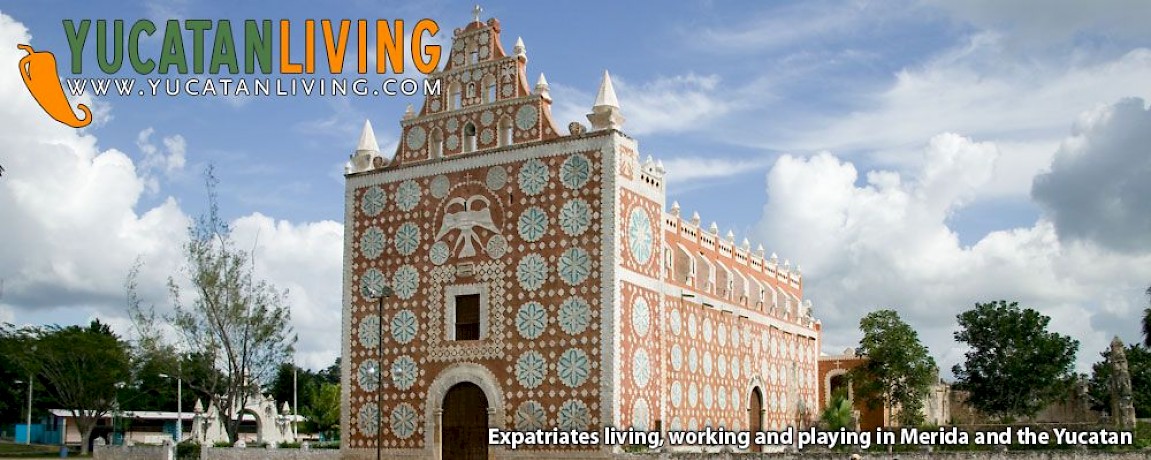


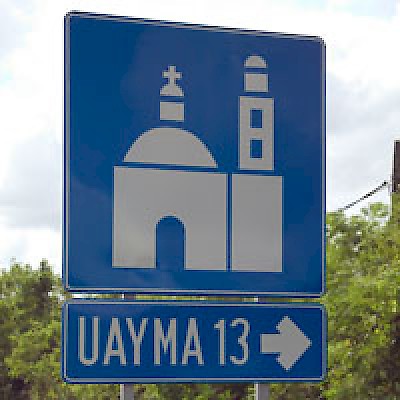
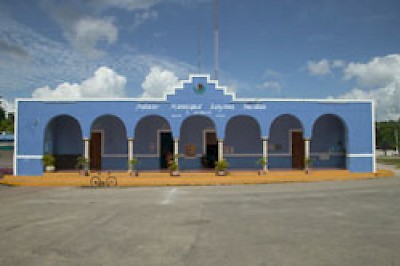
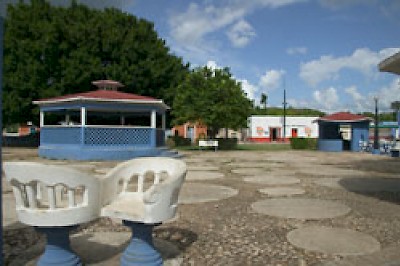
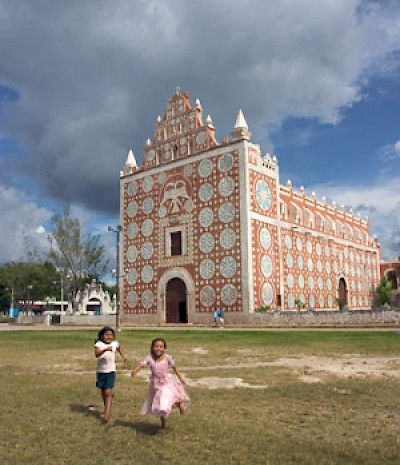
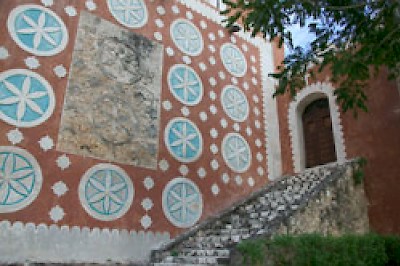
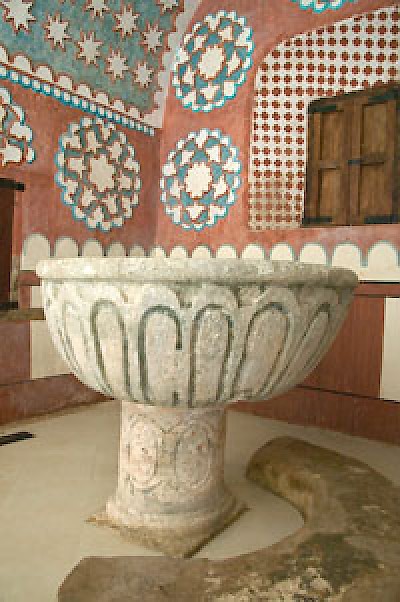
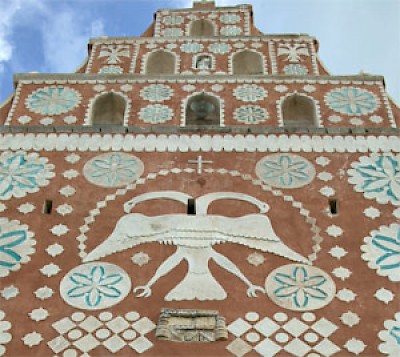
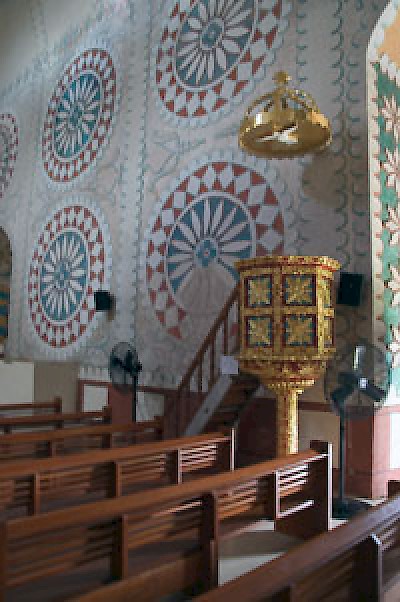

Comments
CasiYucateco 19 years ago
To my understanding, the 5 stars in the Yucatan flag date back before the existence of all the states mentioned by Carlos.
100-200 years ago, it was all "Yucatan". The stars supposedly represent the 5 main 'departamentos' of Yucatan, represented by the main city - the "county seat" of each of the geographic/governmental districts: Merida (1st), Campeche (2nd), Valladolid (3rd), Izamal (4th) and Tekax (5th departamento of Yucatan).
The flag originated in 1841 - along with the Republic of Yucatan - in opposition to Santa Anna's centralization of power in Mexico City.
"Back in the day" supposedly each of the five departamentos had their own flags as well. As far as can be determined (by me), only the Tekax flag design survives. Here is a link to the Flags of the World site showing the Tekax flag:
http://www.fotw.net/flags/mx-tek.html
I've hunted around for any other information about the other 4 missing flags, but to no avail. There's a nice elderly fellow who sells various information about the (old) history of the area at "Noche Mexicana" on the south end of Paseo Montejo Saturdays and a little parque Sunday mornings. He hasn't found the other four either.
Reply
Bob Low 19 years ago
My chances of seeing those beautiful buildings is very slight so I do appreciate the pictures, thank you.
Reply
Joseph 19 years ago
According to the Government, Uayma means "Not Here" :)
http://www.yucatan.gob.mx/estado/municipios/31099a.htm
Reply
Carlos Daniel Gallegos 19 years ago
Thanks so much for this article. I thought that I had explored much in my 2 years in Merida (2003-2005). My 1st visit as a tourist back in 1998, only 4 days. I only scratched the surface. Sad I had to return back to Texas so soon. There was so much I wanted to explore in Merida and the Yucatan. As well as the surrounding Estados. I still call my wife, Ariadna, every month. I still look up articles in Diario de Yucatan on the net.
Have you explained the meaning of the Yucatecan Flag, with its 5 stars yet? My wife says the stars represent the 5 Maya Estados of Mexico: Quintana Roo, Yucatan, Campeche, Tabasco, and Chiapas. It dates back to when the Yucatecos fought Mexico for Independance, and lost. Interesting that it was during the same time as the Texas Independance. Santa Anna squashed the Yucatecos first. Then, made his way to The Alamo.
By the way, we Tejanos are Machismos. lol We call our music Musica Tejano, instead of the correct Spanish, la musica tejana, because we Tejanos (TexMex) feel our music is Macho/hombres, so we don't use the female term for our music. Thanks for the articles.
Reply
Working Gringo 19 years ago
Bienvenidos Larry, you and Flo sure get around, and of course we'd be pleased for you to link to us. Thanks.
CasiYuc, what can we say? The Hapsburg-German-Dutch hex sign connection makes a lot of sense. The double-head eagle even fits in that context. Nice sleuthing. Carry on my wayward son...
Reply
CasiYucateco 19 years ago
The last thought that came to mind... now I really need to get back to work... is that these decorations also seem to have a Moorish appearance: all geometry and few portrayals of life (double-headed eagle excused). The repetition and geometry remind me of some tile work seen in Spain and Northern Africa.
Reply
CasiYucateco 19 years ago
P.P.S. Sorry to keep running off at the mouth. My grandmother was of German ancestry. She had made a "hex sign" to put up on the wall of a cabin my grandfather built in the woods. She loved her double-distlefink blessing sign on the humble cabin she called her "Swiss Chalet."
Even when I was a child, she told us about these - the most common use of these "hex signs" in the USA were by the Pennsylvannia Dutch.
Look at these links and compare some photos to the church:
http://folkart.com/catalog/hexsign-ramona_456306_products.htm
http://www.the-artistic-garden.com/hex-signs.html
Some of the forms are nearly identical. These are supposed to be a very ancient way of asking for a blessing on a building. Googling "hex signs", "barn stars", or sometimes "Pennsylvania Dutch" along with those brings up a lot of resources. There may be some strange German influence or ... the friars who supervised the church construction were versed in these old blessing signs.
Fascinating that some Mayan carvings (at least) are included among them. Surely this is an indication of very strongly held beliefs that were respected by the builders of the church.
Reply
CasiYucateco 19 years ago
P.S. Love, love, love the photos!
For 10 extra points, name this tune:
Masquerading as a man with a reason
My charade is the event of the season
And if I claim to be a wise man, well
It surely means that I don't know
Carry on, you will always remember
Carry on, nothing equals the splendor
The center lights around your vanity
But surely heaven waits for you.
Sorry, I have no idea why that song came to mind while viewing your photos. Yucatan is mysterious indeed.
Reply
CasiYucateco 19 years ago
You loco Working Gringos do such a bang-up job of describing the mysteries of Yucatan! I had seen a Diario de Yucatan article about the restoration of the church and all the painting. But yours is the best article describing the town, convent, brief colonial history and church that I have seen. Thank you for another wonderful travel tale and an inspiration to do more exploring of my own. Cheerio!
Reply
Larry Miller 19 years ago
I am planning my first trip to the Yucatan since 1978. Your blog has been invaluable. With your permission I would like to link to Yucatan Living in a posting about planning our trip.
Thank you
Larry Miller
Reply
geo 19 years ago
Awesome.
Reply
« Back (20 to 31 comments)Next »